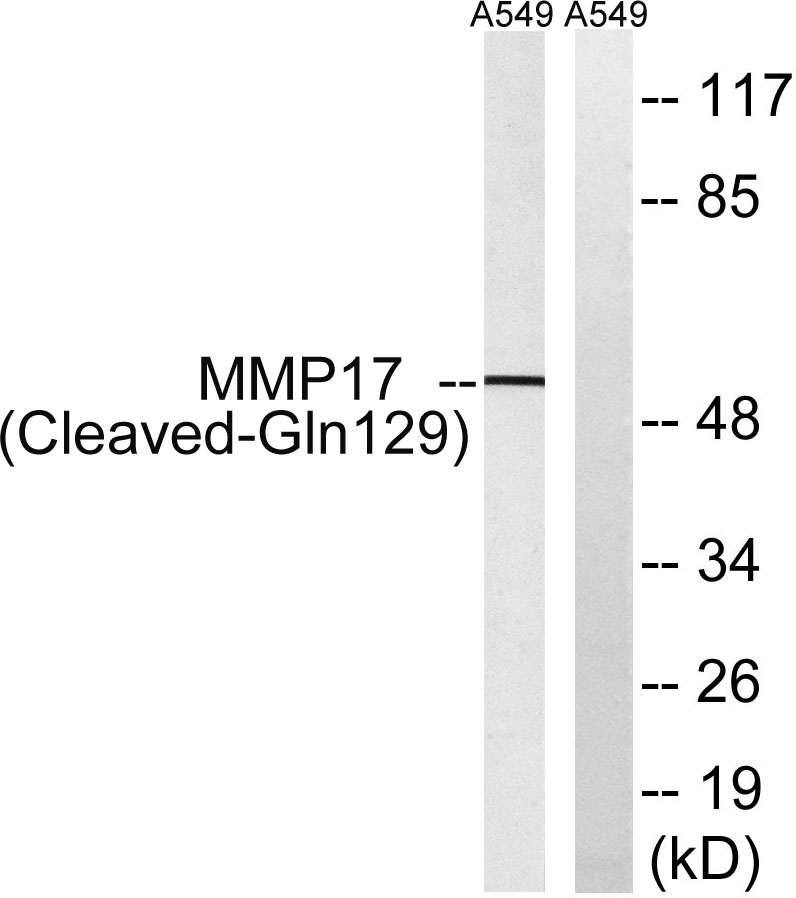Cleaved-MMP-17 (Q129) Polyclonal Antibody
- Catalog No.:YC0063
- Applications:WB;ELISA
- Reactivity:Human;Rat;Mouse;
- Target:
- MMP-17
- Fields:
- >>Parathyroid hormone synthesis, secretion and action
- Gene Name:
- MMP17
- Protein Name:
- Matrix metalloproteinase-17
- Human Gene Id:
- 4326
- Human Swiss Prot No:
- Q9ULZ9
- Mouse Swiss Prot No:
- Q9R0S3
- Immunogen:
- The antiserum was produced against synthesized peptide derived from human MMP17. AA range:110-159
- Specificity:
- Cleaved-MMP-17 (Q129) Polyclonal Antibody detects endogenous levels of fragment of activated MMP-17 protein resulting from cleavage adjacent to Q129.
- Formulation:
- Liquid in PBS containing 50% glycerol, 0.5% BSA and 0.02% sodium azide.
- Source:
- Polyclonal, Rabbit,IgG
- Dilution:
- WB 1:500 - 1:2000. ELISA: 1:10000. Not yet tested in other applications.
- Purification:
- The antibody was affinity-purified from rabbit antiserum by affinity-chromatography using epitope-specific immunogen.
- Concentration:
- 1 mg/ml
- Storage Stability:
- -15°C to -25°C/1 year(Do not lower than -25°C)
- Other Name:
- MMP17;MT4MMP;Matrix metalloproteinase-17;MMP-17;Membrane-type matrix metalloproteinase 4;MT-MMP 4;MTMMP4;Membrane-type-4 matrix metalloproteinase;MT4-MMP;MT4MMP
- Observed Band(KD):
- 53kD
- Background:
- This gene encodes a member of the peptidase M10 family and membrane-type subfamily of matrix metalloproteinases (MMPs). Proteins in this family are involved in the breakdown of extracellular matrix in normal physiological processes, such as embryonic development, reproduction, and tissue remodeling, as well as in disease processes, such as arthritis and metastasis. Members of this subfamily contain a transmembrane domain suggesting that these proteins are expressed at the cell surface rather than secreted. The encoded preproprotein is proteolytically processed to generate the mature protease. This protein is unique among the membrane-type matrix metalloproteinases in that it is anchored to the cell membrane via a glycosylphosphatidylinositol (GPI) anchor. Elevated expression of the encoded protein has been observed in osteoarthritis and multiple human cancers. [provided by RefSeq, Jan 2016],
- Function:
- catalytic activity:Cleaves pro-TNF-alpha at the 74-Ala-|-Gln-75 site.,cofactor:Binds 1 zinc ion per subunit.,cofactor:Calcium.,domain:The conserved cysteine present in the cysteine-switch motif binds the catalytic zinc ion, thus inhibiting the enzyme. The dissociation of the cysteine from the zinc ion upon the activation-peptide release activates the enzyme.,function:Endopeptidase that degrades various components of the extracellular matrix, such as fibrin. May be involved in the activation of membrane-bound precursors of growth factors or inflammatory mediators, such as tumor necrosis factor-alpha. May also be involved in tumoral process. Not obvious if able to proteolytically activate progelatinase A. Does not hydrolyze collagen types I, II, III, IV and V, gelatin, fibronectin, laminin, decorin nor alpha1-antitrypsin.,PTM:The precursor is cleaved by a furin endopeptidase.,similarity:Be
- Subcellular Location:
- [Isoform Long]: Cell membrane; Lipid-anchor, GPI-anchor; Extracellular side. Secreted, extracellular space, extracellular matrix.
- Expression:
- Expressed in brain, leukocytes, colon, ovary testis and breast cancer. Expressed also in many transformed and non-transformed cell types.
- June 19-2018
- WESTERN IMMUNOBLOTTING PROTOCOL
- June 19-2018
- IMMUNOHISTOCHEMISTRY-PARAFFIN PROTOCOL
- June 19-2018
- IMMUNOFLUORESCENCE PROTOCOL
- September 08-2020
- FLOW-CYTOMEYRT-PROTOCOL
- May 20-2022
- Cell-Based ELISA│解您多样本WB检测之困扰
- July 13-2018
- CELL-BASED-ELISA-PROTOCOL-FOR-ACETYL-PROTEIN
- July 13-2018
- CELL-BASED-ELISA-PROTOCOL-FOR-PHOSPHO-PROTEIN
- July 13-2018
- Antibody-FAQs
- Products Images

- Western Blot analysis of various cells using Cleaved-MMP-17 (Q129) Polyclonal Antibody

- Western blot analysis of lysates from A549 cells, treated with etoposide 25uM 1h, using MMP17 (Cleaved-Gln129) Antibody. The lane on the right is blocked with the synthesized peptide.



